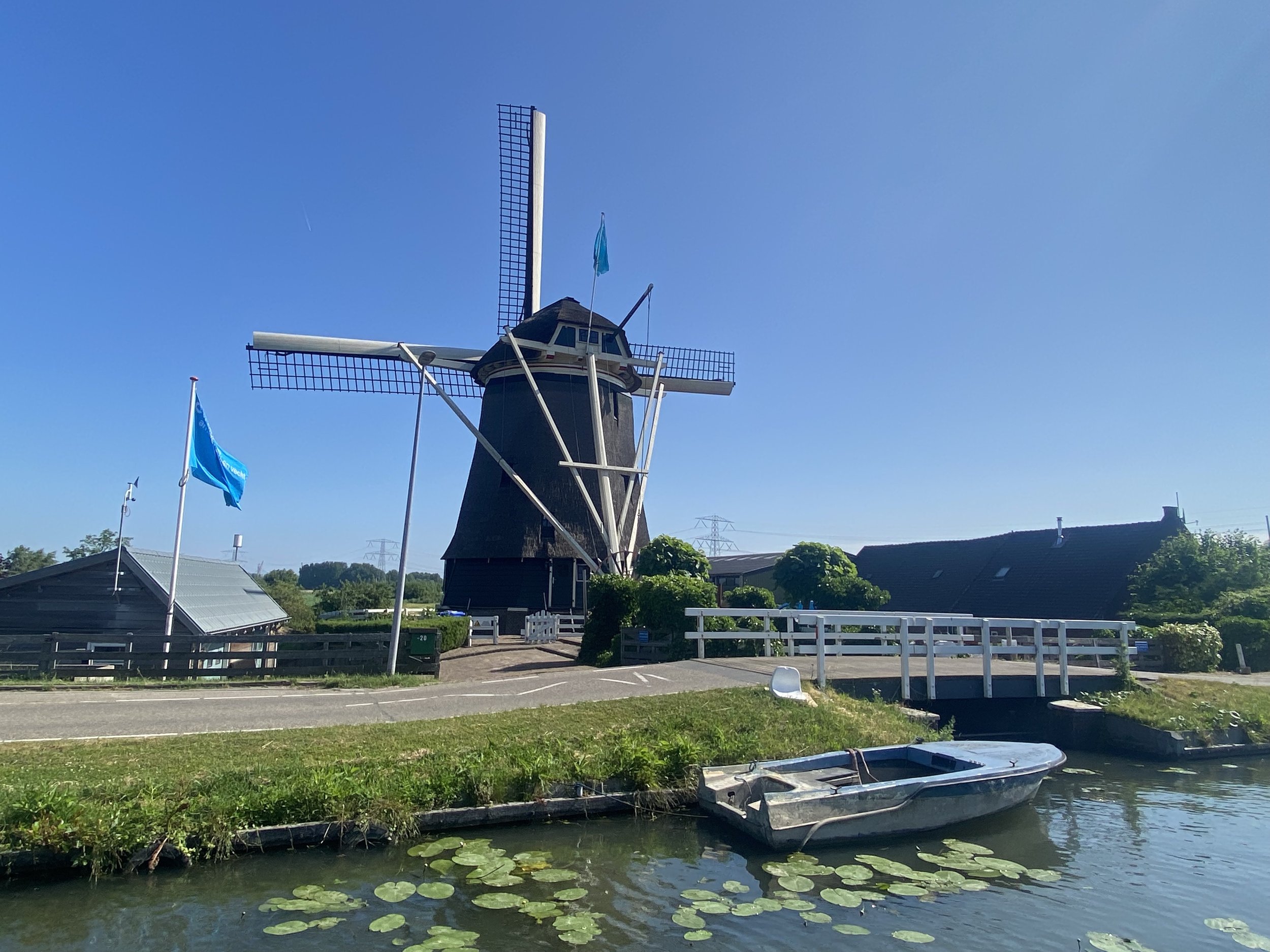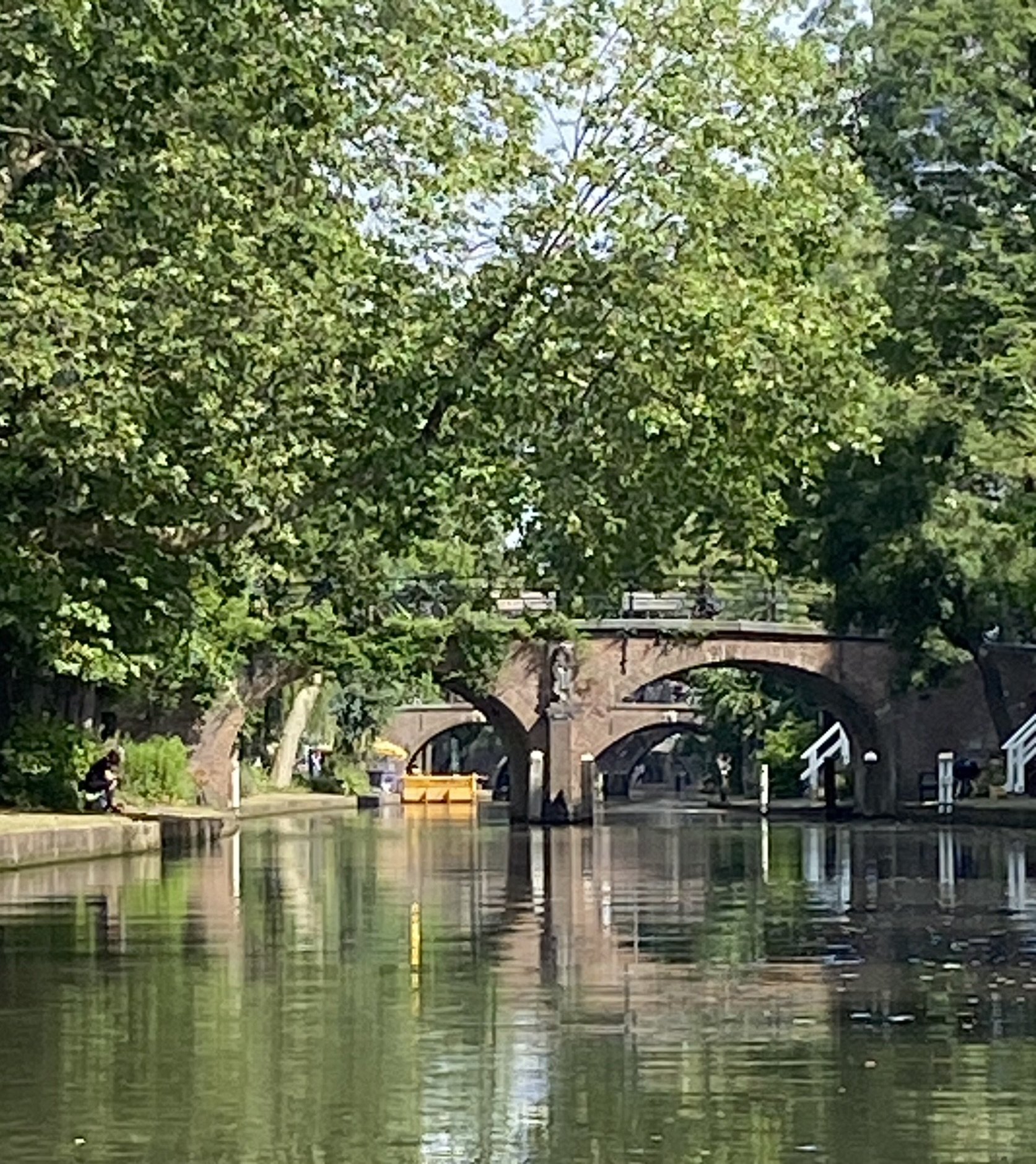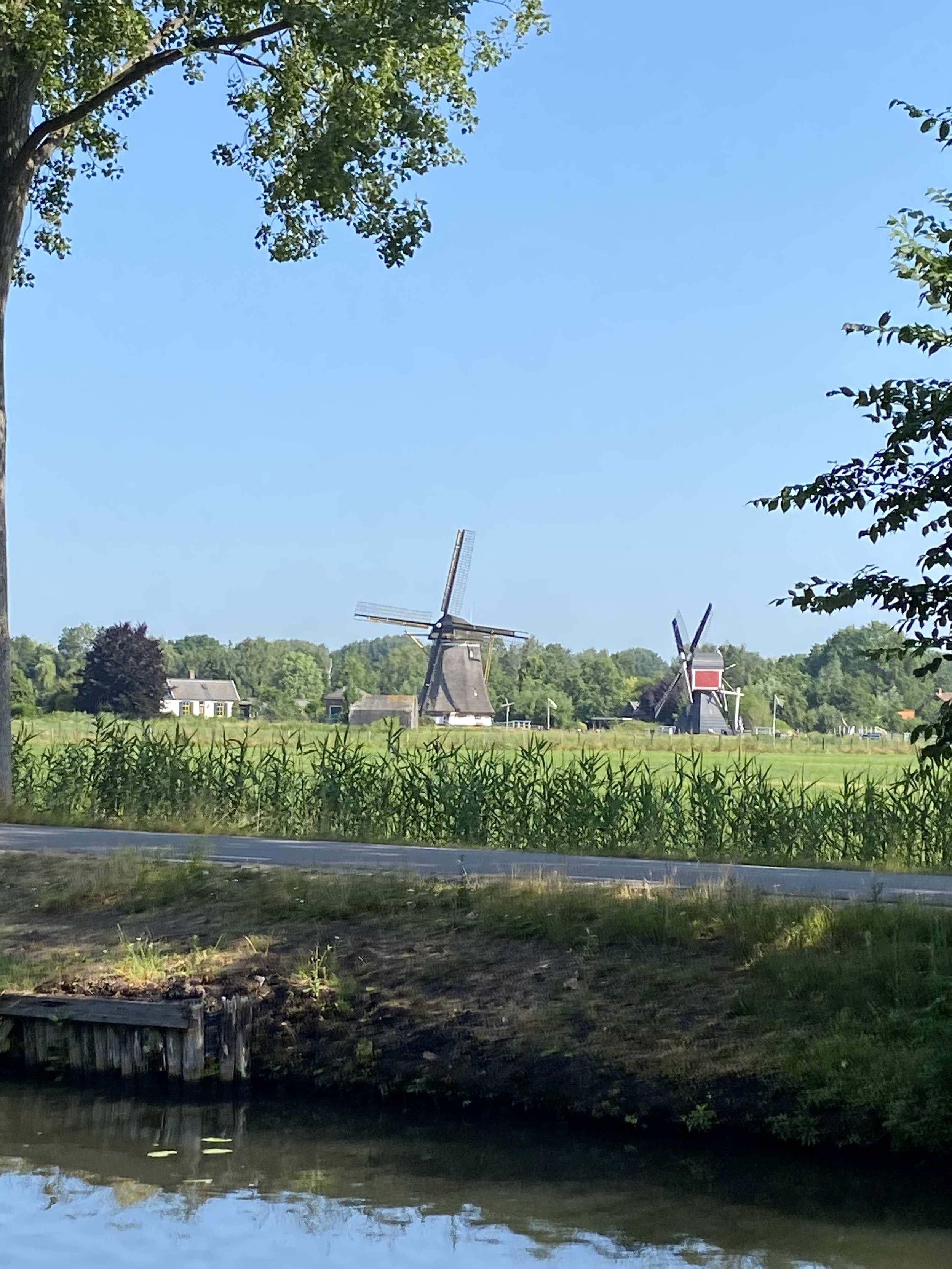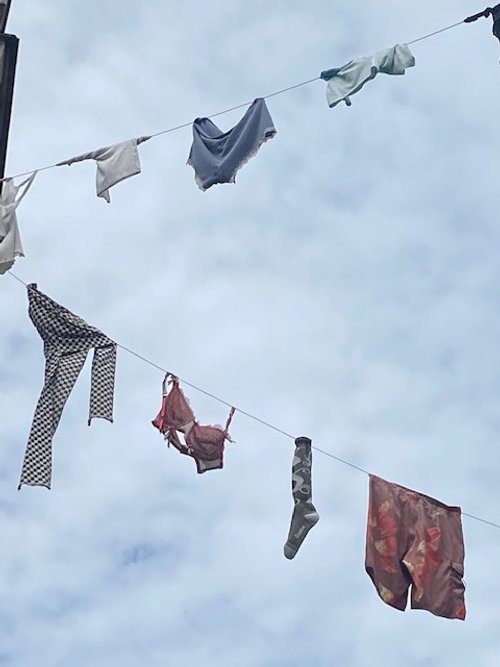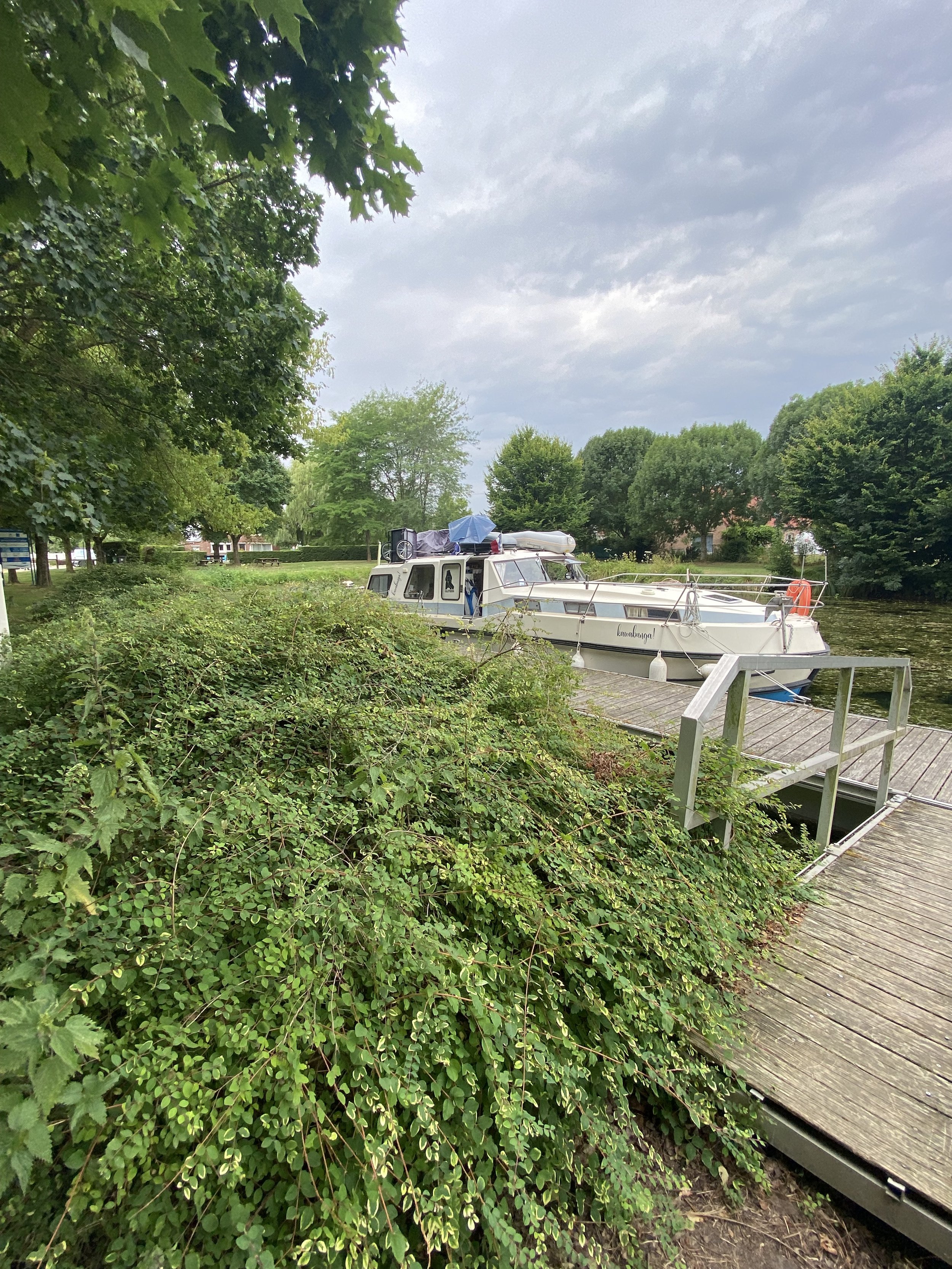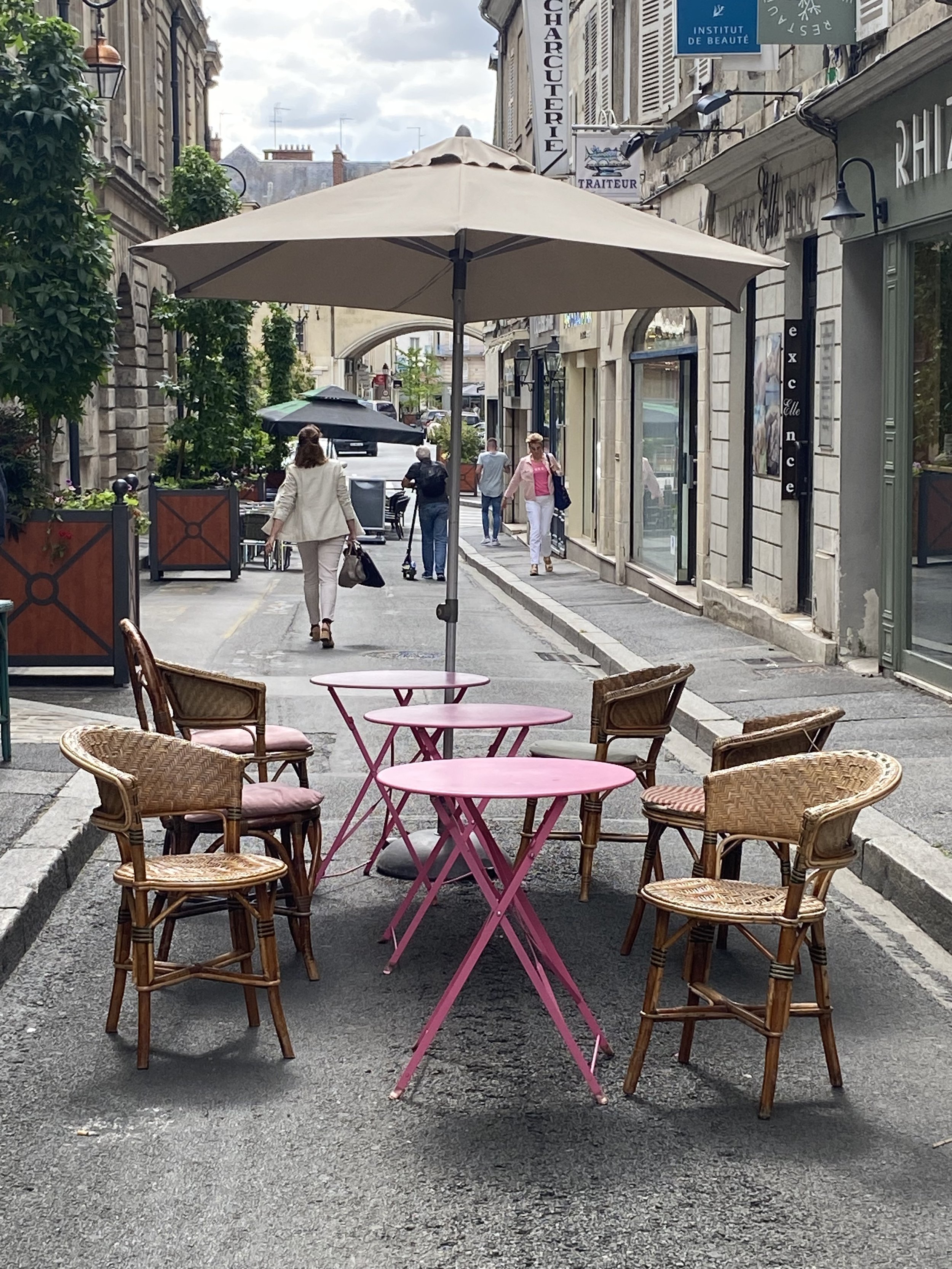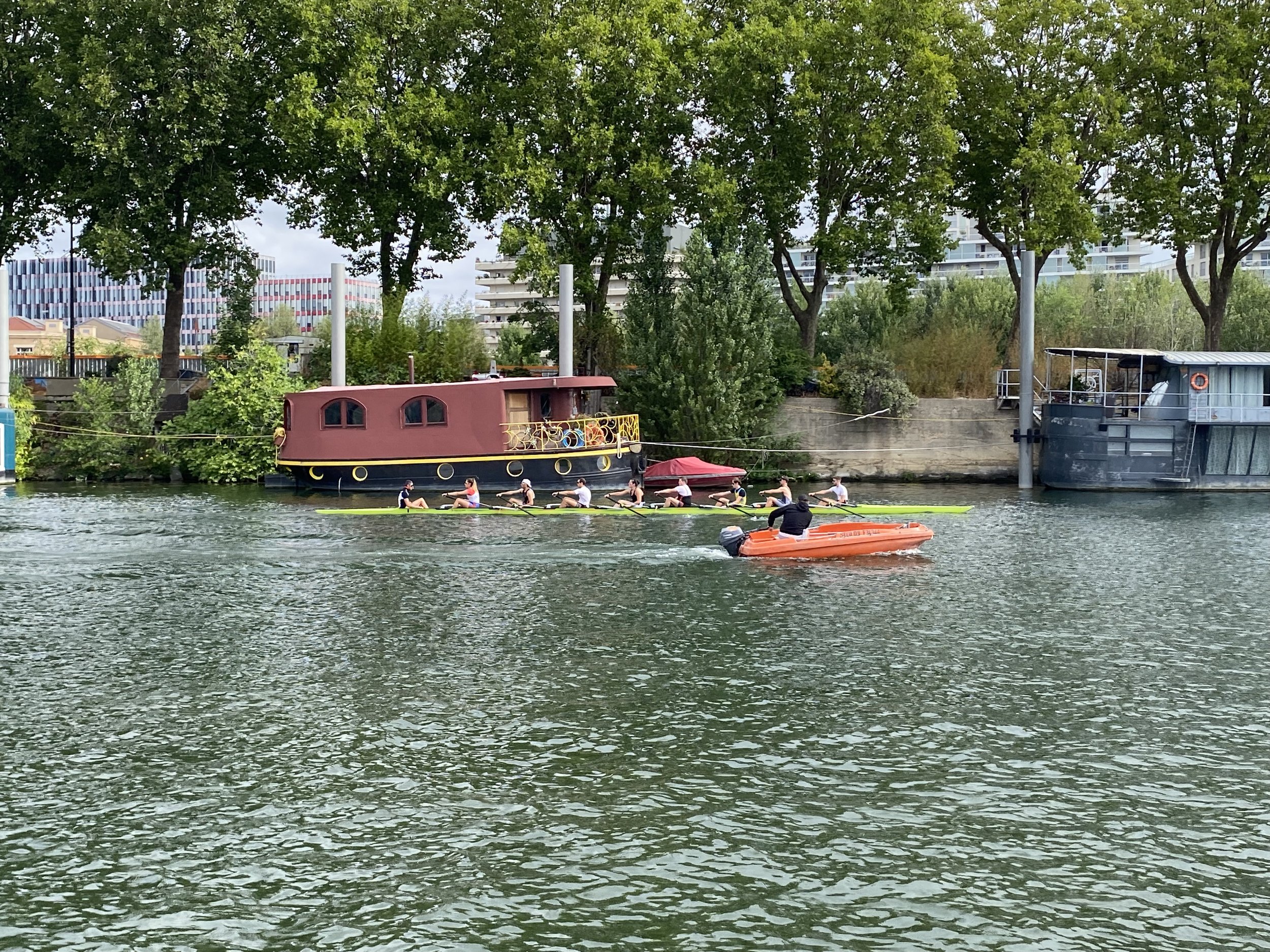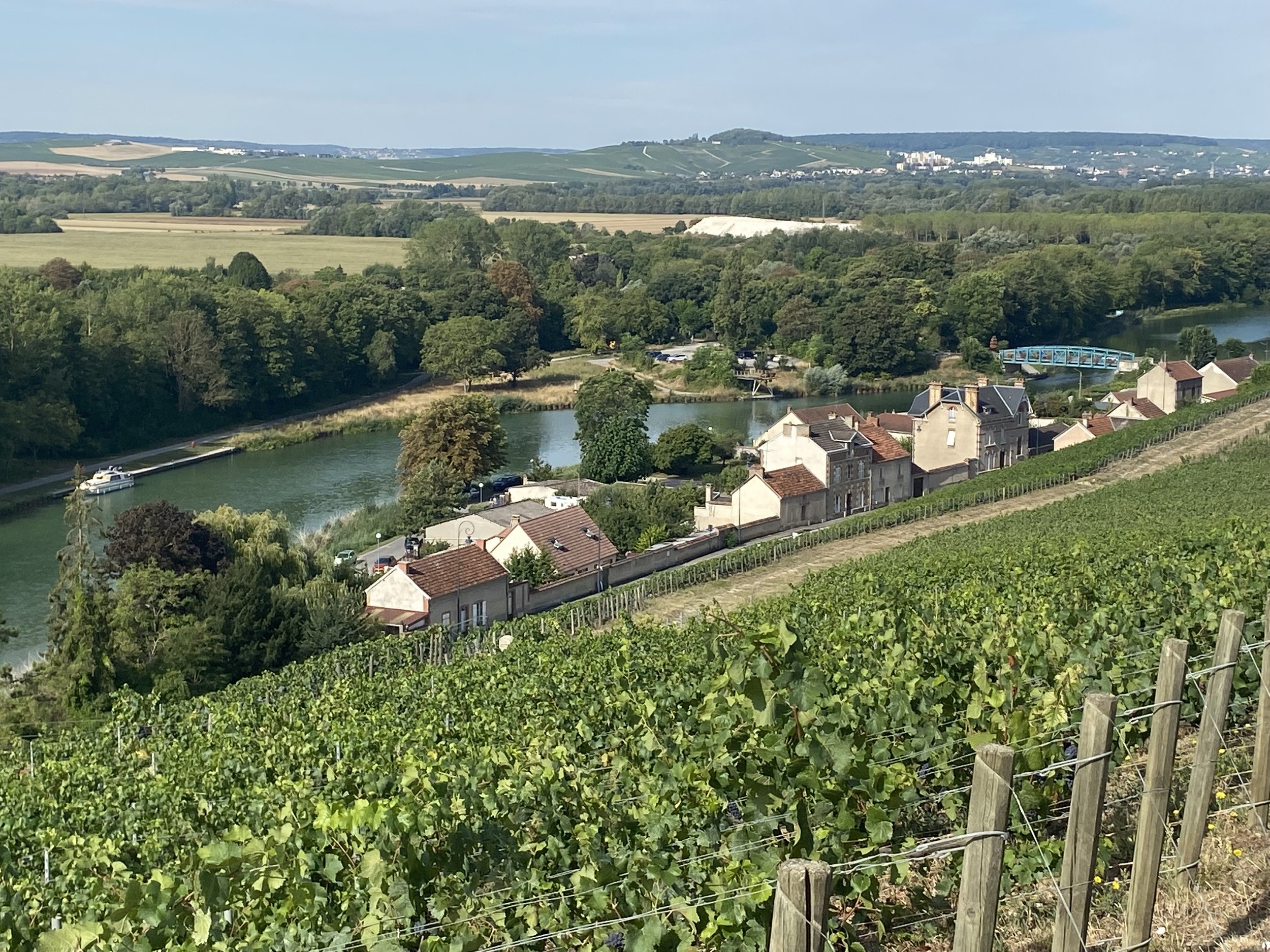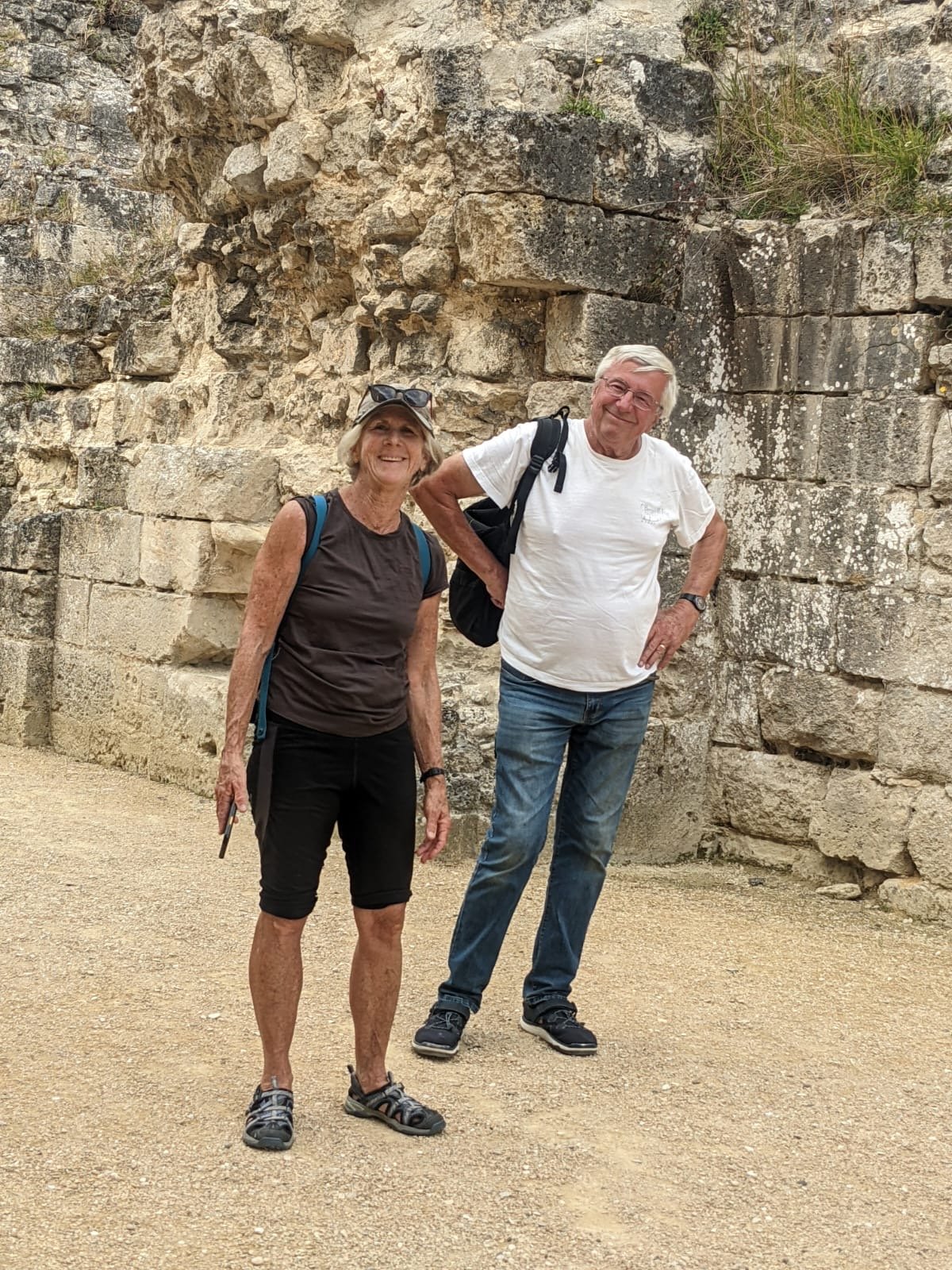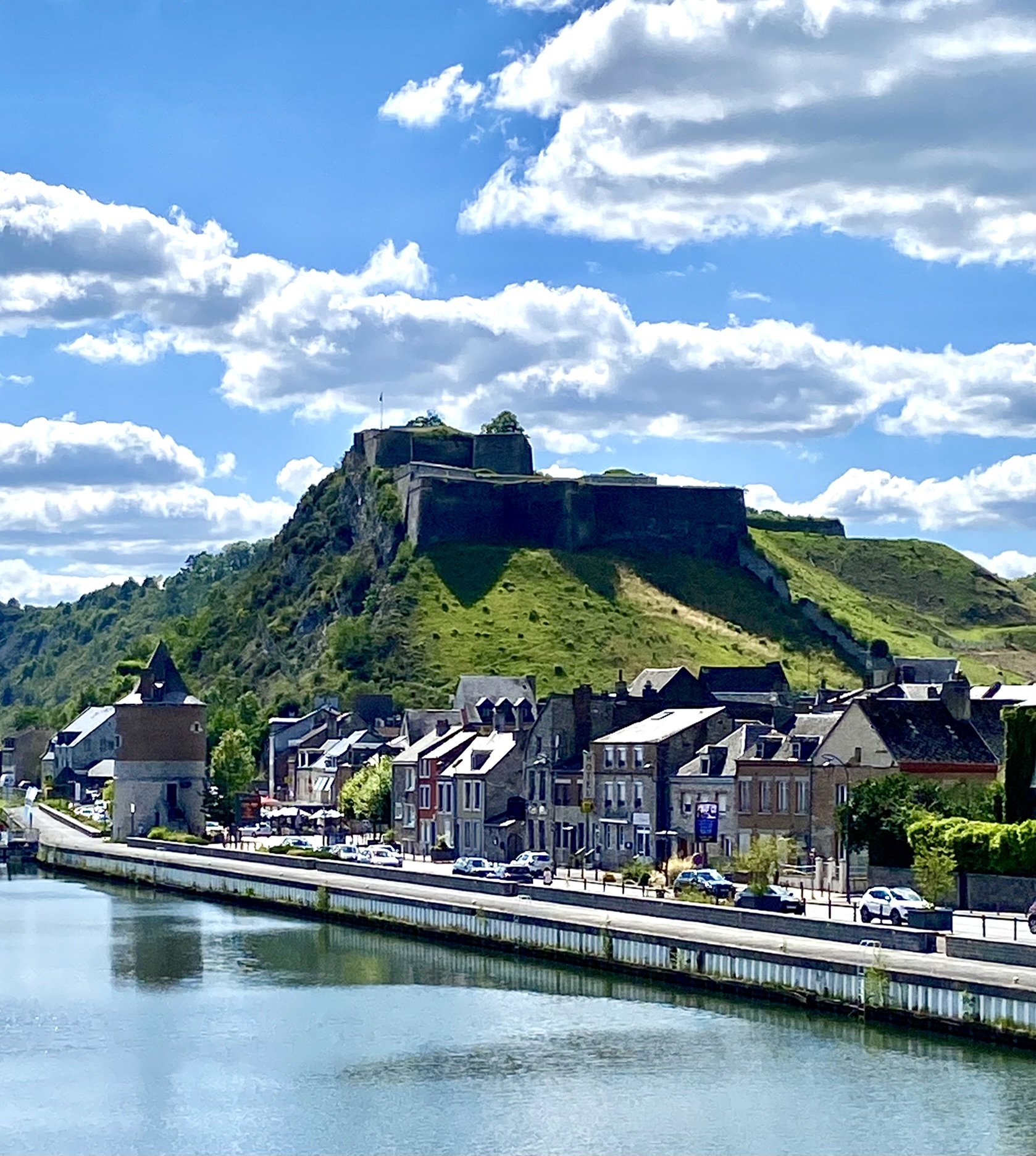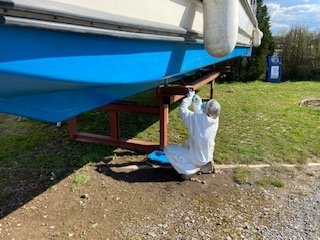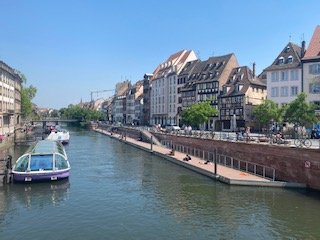A Change in Plans / Changement de Plans
/The rather regular July occurence that helped us change our plans
ENGLISH
August 10, 2023
“Living the dream” isn’t always dreamy.
Just after leaving Amsterdam, where I left off last time, we had a major engine hiccup when our transmission cable broke just as we were leaving a fuel dock. We quickly aborted our intention to pass through the bridge just round the bend, in the town of Purmerend. No longer able to go in reverse, and unable to slow down as the engine was stuck in forward gear, Michel maneuvered as best he could, making a quick U-turn and crash landing at the nearest dock (and luckily there was one!). I was able to jump off, dock line in hand, boat flailing about, while “kinda-sorta” tying the ship down to the first available “cleat” before Michel could shut off the engine. It was acrobatic, hectic, and not without some yelling. It turns out we landed in the perfect place in a small little marina. Within 15 minutes Michel found a competent mechanic nearby who went the extra mile to find us the part and do the repair. Within two days all was back in order. The town of Purmerend turned out to be delightful and handy: laundromat, barber for Michel, and a supermarket all within 5 minutes walking distance, and a lively cute town center to boot. It was a perfect place to be “stuck.”
where we landed when the transmission cable broke
Newly “engineered” we continued on to Edam, in the company of our French friends aboard Boreal, and the summer cheese market that was supposed to kick off on July 5. However, surprise hurricane-force Storm Poly, put the “kabosh” on that and we hunkered down for quite a morning of howling winds, flying branches, and a waltzing boat that broke from its mooring. It totally took Holland by surprise. We hadn’t been in such a violent storm since our episode on Cowabunga, off the coast of Uruguay in 1982. But at least we weren’t on the ocean this time! Edam was charming and we took advantage of the warm and gorgeous weather the following day. (Note: I tried to post a video here of the storm as I had on Facebook, but it just wouldn’t work in this format for some reason).
After that we crossed another large body of water (the Markermeer) and continue up to the northern most point possible for us in Friesland, somewhat tracing an arc with stops in the picturesque towns of Giethoorn (Goat Horns as the story goes), Leeuwarden, Dokkum, and finally Groningen before heading down the easternmost waterways, skirting the German border on our way to Maastricht, then crossing the border into Liege, Belgium.
OUR NORTHERNMOST POINT, IN FRIESLAND, LATITUDE 53°22’ NORTH, EQUIVALENT TO SOUTHERN ALASKA. IT WASN’T TOO COLD BUT THERE WAS A STEADY, HEFTY WIND. TIME TO TURN AROUND!
Originally, we had planned to spend the whole season, and possibly a good portion of next summer in Holland, leaving the boat there for the winter. However, the weather for most of July has been quite unpleasant, with rain almost every day. That, combined a fairly uniform (eventually monotonous), landscape and our generally being nonplussed with the Dutch and the Netherlands (see “Sketch” below), conspired to help us change our minds and head back to France, where we’ll be leaving the boat in the same place as last year, the town of Hautmont near Lille.
We arrived back in Hautmont a few days ago, after revisiting the pleasant city of Namur in Belgium, and bumping into some Australian friends from last year. Vacation is over as we attack the chores of cleaning, stripping, mending (there are always repairs to be done), and winterizing Kawabunga, readying it for its dry-dock haul out in a couple of weeks.
We shall see where the water leads us next year.
Holland: A Brief “Impressionist” Sketch
• A well-manicured country, meticulous lawns, and landscaping; few fences.
• Fine taste in architecture and style: clean lines, a thirst for light (new homes and older homes alike sport big, wide windows); tasteful modern homes that blend in seamlessly with traditional styles; however, although pleasant to look at, it all eventually struck us as somewhat “sterilized” lacking character, a bit too “perfect”, too well-done, too much of a good thing.
• Well laid out communities: good workable urban flow and function, priority given to bicycles, pedestrians; traffic signals and major intersections for bikes only; so easy to get around without a car!
• Many towns, villages, communities are concentrated around boats and bikes: bike paths, front or backyard docks; seems like more boats and bikes than people! Many neighborhoods look very American: houses and landscaping.
However, despite the apparent cleanliness, we were stuck by the amount of discarded cigarette butts, and some plastic and papers strewn in gutters in cities; nevertheless, graffiti is rare.
• Very green, peaceful, flat, and scenic countryside, but not spectacular, eventually bordering on monotony.
• A frugal people, almost too much: credit cards often not accepted; cash preferred, or Dutch debit cards only.
• Insular people, somewhat stand-offish, polite but not outgoing or overly friendly; not exuberant; however, since almost everyone speaks English, it is easy to communicate, from the cashier in the grocery store, to the “man-on-the-street”, to the bridge or lock tender, to the anonymous voice on the phone from whom I’m trying to extract information, English is the norm. However, this doesn’t exclude our frustration when canal/bridge/or lock signs are only in Dutch (and tiny print barely visible from the boat!) and it takes some tedious Google translating to often get a gist of things.
• For our French tastes, we were frustrated by the lack of variety in food choices, and no real Dutch cuisine to speak of, and most importantly: REALLY BAD BREAD!
a meeting of the CANALs
FRANCAIS
10 août 2023
"Vivre le rêve" n'est pas toujours un rêve.
Juste après avoir quitté Amsterdam, où je m'étais arrêté la dernière fois, nous avons eu un gros problème de moteur lorsque notre câble de transmission s'est rompu juste au moment où nous quittions un quai de ravitaillement. Nous avons rapidement abandonné notre intention de passer par le pont juste après le virage, dans la ville de Purmerend. Ne pouvant plus faire marche arrière, ni ralentir, le moteur étant bloqué en marche avant, Michel a manœuvré du mieux qu'il a pu, faisant un demi-tour rapide et atterrissant en catastrophe sur le quai le plus proche (et heureusement qu'il y en avait un !). J'ai pu sauter, une amarre à la main, le bateau vacillant, tout en attachant le bateau au premier "taquet" disponible avant que Michel ne puisse couper le moteur. C'était acrobatique, trépidant, et non sans quelques cris. Il s'est avéré que nous avons atterri à l'endroit idéal, dans une petite marina. En moins de 15 minutes, Michel a trouvé un mécanicien compétent à proximité qui s'est démené pour nous trouver la pièce et effectuer la réparation. Deux jours plus tard, tout était rentré dans l'ordre. La ville de Purmerend s'est avérée charmante et pratique : une laverie, un coiffeur pour Michel et un supermarché à 5 minutes à pied, et un centre ville animé et mignon en plus. C'était un endroit parfait pour être "coincé".
There is always a bridge to wait for in the Netherlands. Not many locks, but tons and tons of bridges! some have decorative murals or publicity underneath.
Tout étant réparé, nous avons poursuivi notre route vers Edam et le marché du fromage d'été qui devait démarrer le 5 juillet, en compagnie de nos amis français à bord de Boreal. Cependant, la tempête surprise Poly, de la force d'un ouragan, a mis le holà à tout cela et nous nous sommes réfugiés à bord pour une matinée de vents hurlants, de branches volantes et d'un bateau valsant qui s'est détaché de son amarrage. La Hollande a été totalement prise par surprise. Nous n'avions pas été confrontés à une tempête aussi violente depuis notre épisode sur Cowabunga, au large de la côte uruguayenne, en 1982. Mais au moins, cette fois-ci, nous n'étions pas sur l'océan ! Edam était charmant et nous avons profité du temps chaud et magnifique le lendemain.
Nous avons ensuite traversé une autre grande étendue d'eau (la Markermeer) et continué jusqu'au point le plus septentrional possible pour nous en Frise, traçant en quelque sorte un arc de cercle avec des arrêts dans les villes pittoresques de Giethoorn (Goat Horns comme le dit l'histoire), Leeuwarden, Dokkum, et enfin Groningen avant de nous diriger vers les voies navigables les plus à l'est, longeant la frontière allemande en route vers Maastricht, puis traversant la frontière vers Liège, en Belgique.
Picturesque town of Giethoorn, a major tourist attraction
Montagne de Bueren, Liege, belgium, 374 steps
À l'origine, nous avions prévu de passer toute la saison, et peut-être une bonne partie de l'été prochain, en Hollande, en y laissant le bateau pour l'hiver. Cependant, le temps a été assez désagréable pendant la majeure partie du mois de juillet, avec de la pluie presque tous les jours. Ceci, combiné à un paysage assez uniforme (finalement monotone) et à notre incompréhension générale des Néerlandais et des Pays-Bas (voir "Esquisse" ci-dessous), nous a fait changer d'avis et retourner en France, où nous laisserons le bateau au même endroit que l'année dernière, la ville d'Hautmont près de Lille.
Nous sommes arrivés à Hautmont il y a quelques jours, après avoir revisité l'agréable ville de Namur en Belgique, et retrouvé des amis australiens de l'année dernière. Les vacances sont terminées et nous attaquons les tâches de nettoyage, de décapage, de réparation (il y a toujours des réparations à faire) et d'hivernage de Kawabunga, afin de le préparer pour son passage en cale sèche dans quelques semaines.
Nous verrons bien où les courants nous mèneront l'année prochaine.
La Hollande : Une brève esquisse "impressionniste” :
• Un pays bien entretenu, des pelouses et des aménagements paysagers méticuleux, peu de clôtures.
• Un goût prononcé pour l'architecture et le style : des lignes épurées, une soif de lumière (les nouvelles maisons comme les anciennes arborent de grandes et larges fenêtres) ; des maisons modernes de bon goût qui s'intègrent parfaitement aux styles traditionnels ; cependant, bien qu'agréable à regarder, tout cela nous a finalement semblé quelque peu "aseptisé", manquant de caractère, un peu trop "parfait", trop bien fait, trop d'une bonne chose.
• Communautés bien aménagées : flux et fonctionnement urbains efficaces, priorité donnée aux vélos et aux piétons ; feux de circulation et intersections principales réservés aux vélos ; il est si facile de se déplacer sans voiture !
• De nombreuses villes, villages et communautés se concentrent autour des bateaux et des vélos : pistes cyclables, quais à l'avant ou dans l'arrière-cour ; il semble qu'il y ait plus de bateaux et de vélos que d'habitants ! De nombreux quartiers ont un aspect très américain : maisons et aménagements paysagers.
Cependant, malgré la propreté apparente, nous avons été interpellés par la quantité de mégots de cigarettes jetés, et plastiques et papiers éparpillés dans les caniveaux des villes ; néanmoins, les graffitis sont rares.
• Une campagne très verte, paisible, plate et pittoresque, mais pas spectaculaire, devenant très vite monotone.
• Un peuple frugal, presque trop : les cartes de crédit ne sont souvent pas acceptées ; les espèces sont préférées, ou les cartes de débit néerlandaises uniquement.
• Un peuple insulaire, quelque peu distant, poli mais pas extraverti ou trop amical ; pas exubérant. Cependant, comme presque tout le monde parle anglais, il est facile de communiquer, du caissier de l'épicerie à "l'homme de la rue", en passant par le gardien du pont ou de l'écluse, jusqu'à la voix anonyme au téléphone dont j'essaie d'extraire des informations, l'anglais est la norme. Cependant, cela n'exclut pas notre frustration lorsque les panneaux de signalisation des canaux, des ponts ou des écluses ne sont qu'en néerlandais (et en petits caractères à peine visibles depuis le bateau !) et qu'il faut recourir à une fastidieuse traduction sur Google pour avoir une idée générale de ce qui se passe.
• Pour nos goûts français, nous avons été frustrés par le manque de variété dans le choix des aliments, l'absence d'une véritable cuisine néerlandaise et, surtout, le fait que le pain soit vraiment mauvais ! LE PAIN EST VRAIMENT MAUVAIS !
Modern neighborhood
another example of a contemporary home
contemporary home
contemporary home
contemporary apartments/townhomes
cheese in edam
more cheese
bridge in edam
kawabunga passing through a bridge in edam, photo credt Jean-Michel chessari, boat boreal
Not all transport is by bike or boat
A “nature” mooring for the night
Small individually powered ferry
Leaning tower in Leeuwarden that the locals are proud of. Also it was never finished and they are proud of their abbreviated version
Artst M.C. Escher is honored in his birthplace of leeuwarden
dokkum
another “nature” mooring, something we prefer
Harbor liveaboards in groningen
multiuse complex forum in groningen
typical dutch landscape, polders
prison in leeuwarden transformed into restaurant/library/multi use center
on our way down south along the eastern border, many bridges and locks were manually operated
formerly a church, now converted into a popular bookstore in Maastricht. Many churches are now hotels, restaurants, etc.
Maastricht Underground, where much of Maastricht’s history is the real story
They aren’t just for show!
Storks
coming into “charming” charleroi, Belgium
Passing through the center of Charleroi, nicknamed “mad Max” amongst boaters
some more varied scenery near Namur, Belgium





































